A Study on the Mechanism and Kinetics of Ultrasound-Enhanced Sulfuric Acid Leaching for Zinc Extraction from Zinc Oxide Dust
Abstract
:1. Introduction
2. Experimental Materials and Characterization
2.1. Analysis on the Composition of Raw Materials
2.2. Analysis on Mineral Phase
2.3. Experimental Methods
3. Experimental Results and Relevant Analysis
3.1. Experimental Study on Ultrasound-Enhanced Leaching Conditions
3.1.1. Effect of Ultrasonic Power on Zinc Leaching Rate
3.1.2. Effect of Sulfuric Acid Concentration on Zinc Leaching Rate
3.1.3. Effect of Liquid–Solid Ratio on Zinc Leaching Rate
3.1.4. Effect of Rotating Speed on Zinc Leaching Rate
3.1.5. Effect of Temperature on Zinc Leaching Rate
3.2. Kinetics of Ultrasound-Enhanced Leaching
3.3. Comparative Experiment of Conventional-Ultrasonic Leaching
3.4. Analysis of Leaching Mechanism
3.4.1. Characterization by XRD
3.4.2. Comparative Analysis of SEM-EDS
3.4.3. Particle Size Analysis and Mechanism of Leaching ZOD
4. Conclusions
- (1)
- Through an ultrasound-enhanced sulfuric acid leaching experiment, the optimal zinc leaching conditions for zinc oxide dust were determined as follows: leaching temperature of 25 °C; ultrasonic power of 500 W; sulfuric acid concentration of 140 g/L; liquid–solid ratio of 5:1; rotating speed of 100 rpm; and a leaching time of 30 min—for which the zinc leaching rate could reach up to 91.16%.
- (2)
- In a kinetic analysis of the ultrasound-enhanced sulfuric acid leaching of zinc oxide dust, the initial apparent activation energy of the reaction was 6.90 kJ/mol. indicating that the ultrasound-enhanced leaching of zinc oxide dust was primarily controlled by the mixed control of the solid product layers.
- (3)
- The leached residue was characterized by XRD and SEM-EDS, and the results showed that with ultrasonic waves, the encapsulated mineral particles were dissociated, and the dissolution of ZnO was enhanced. Mostly, the zinc in the leached residue existed in the forms of ZnFe2O4, Zn2SiO4, and ZnS accompanied by large amounts of PbSO4, PbS, and SiO2.
Author Contributions
Funding
Institutional Review Board Statement
Informed Consent Statement
Data Availability Statement
Acknowledgments
Conflicts of Interest
References
- Nayak, A.; Jena, M.S.; Mandre, N.R. Beneficiation of lead-zinc ores—A review. Miner. Process. Extr. Metall. Rev. 2021, 43, 1–20. [Google Scholar] [CrossRef]
- Jia, N.N.; Wang, H.G.; Zhang, M.; Guo, M. Selective and Efficient Extraction of Zinc from Mixed Sulfide–oxide Zinc and Lead Ore. Miner. Process. Extr. Metall. Rev. 2016, 37, 418–426. [Google Scholar] [CrossRef]
- Ma, A.Y.; Peng, J.H.; Zhang, L.B.; Li, S.W.; Yang, K.; Zheng, X.M. Leaching Zn from the Low-Grade Zinc Oxide Ore in NH3-H3C6H5O7-H2O Media. Braz. J. Chem. Eng. 2016, 33, 907–917. [Google Scholar] [CrossRef]
- Yang, K.; Zhang, L.B.; Zhu, X.C.; Peng, J.H.; Li, S.W.; Ma, A.Y.; Li, H.Y.; Zhu, F. Role of manganese dioxide in the recovery of oxide-sulphide zinc ore. J. Hazard. Mater. 2018, 343, 315–323. [Google Scholar] [CrossRef]
- Dong, M.G.; Xue, X.X.; Kumar, A.; Yang, H.; Sayyed, M.I.; Liu, S.; Bu, E. A novel method of utilization of hot dip galvanizing slag using the heat waste from itself for protection from radiation. J. Hazard. Mater. 2018, 344, 602–614. [Google Scholar] [CrossRef]
- Rudnik, E. Recovery of zinc from zinc ash by leaching in sulphuric acid and electrowinning. Hydrometallurgy 2019, 188, 256–263. [Google Scholar] [CrossRef]
- Zhang, B.K.; Guo, X.Y.; Wang, Q.M.; Tian, Q.H. Thermodynamic analysis and process optimization of zinc and lead recovery from copper smelting slag with chlorination roasting. Trans. Nonferrous Met. Soc. China 2021, 31, 3905–3917. [Google Scholar] [CrossRef]
- Xia, Z.; Zhang, X.; Huang, X.; Yang, S.; Ye, L. Hydrometallurgical stepwise recovery of copper and zinc from smelting slag of waste brass in ammonium chloride solution. Hydrometallurgy 2020, 197, 105475. [Google Scholar] [CrossRef]
- Ma, A.Y.; Zheng, X.M.; Gao, L.; Li, K.Q.; Omran, M.; Chen, G. Enhanced Leaching of Zinc from Zinc-Containing Metallurgical Residues via Microwave Calcium Activation Pretreatment. Metals 2021, 11, 1922. [Google Scholar] [CrossRef]
- Wang, J.; Zhang, Y.Y.; Cui, K.K.; Fu, T.; Gao, J.J.; Hussain, S.; AlGarni, T.S. Pyrometallurgical recovery of zinc and valuable metals from electric arc furnace dust—A review. J. Clean. Prod. 2021, 298, 126788. [Google Scholar] [CrossRef]
- Luo, X.G.; Wang, C.Y.; Shi, X.G.; Li, X.B.; Wei, C.; Li, M.T.; Deng, Z.G. Selective separation of zinc and iron/carbon from blast furnace dust via a hydrometallurgical cooperative leaching method. Waste Manag. 2022, 139, 116–123. [Google Scholar] [CrossRef] [PubMed]
- Zhang, Z.Y.; Peng, J.H.; Srinivasakannan, C.; Zhang, Z.B.; Zhang, L.B.; Fernández, Y.; Menéndez, J.A. Leaching zinc from spent catalyst: Process optimization using response surface methodology. J. Hazard. Mater. 2010, 176, 1113–1117. [Google Scholar] [CrossRef]
- Ma, A.Y.; Zheng, X.M.; Liu, C.H.; Peng, J.H.; Li, S.W.; Zhang, L.B.; Liu, C. Study on regeneration of spent activated carbon by using a clean technology. Green Process. Synth. 2017, 6, 499–510. [Google Scholar] [CrossRef]
- Ma, A.Y.; Zheng, X.M.; Li, K.Q.; Omran, M.; Chen, G. The adsorption removal of tannic acid by regenerated activated carbon from the spent catalyst of vinyl acetate synthesis. J. Mater. Res. Technol. 2021, 10, 697–708. [Google Scholar] [CrossRef]
- Zhan, L.; Li, O.Y.; Xu, Z.M. Preparing nano-zinc oxide with high-added-value from waste zinc manganese battery by vacuum evaporation and oxygen-control oxidation. J. Clean. Prod. 2020, 251, 119691. [Google Scholar] [CrossRef]
- Meng, L.; Zhong, Y.W.; Guo, L.; Wang, Z.; Chen, K.Y.; Guo, Z.C. Recovery of cu and Zn from waste printed circuit boards using super-gravity separation. Waste Manag. 2018, 78, 559–565. [Google Scholar] [CrossRef] [PubMed]
- Song, J.Q.; Peng, C.; Liang, Y.J.; Zhang, D.K.; Lin, Z.; Liao, Y.; Wang, G.J. Efficient extracting germanium and gallium from zinc residue by sulfuric and tartaric complex acid. Hydrometallurgy 2021, 202, 105599. [Google Scholar] [CrossRef]
- Rao, S.; Wang, D.X.; Liu, Z.Q.; Zhang, K.F.; Cao, H.Y.; Tao, J.Z. Selective extraction of zinc, gallium, and germanium from zinc refinery residue using two stage acid and alkaline leaching. Hydrometallurgy 2018, 183, 38–44. [Google Scholar] [CrossRef]
- Kaya, M.; Hussaini, S.; Kursunoglu, S. Critical review on secondary zinc resources and their recycling technologies. Hydrometallurgy 2020, 195, 105362. [Google Scholar] [CrossRef]
- Xue, Y.; Hao, X.S.; Liu, X.M.; Zhang, N. Recovery of Zinc and Iron from Steel Mill Dust—An Overview of Available Technologies. Materials 2022, 15, 4127. [Google Scholar] [CrossRef]
- Ma, A.Y.; Li, Y.Y.; Li, M.X.; Zheng, X.M. Zinc extraction from zinc oxide dust by tartrate. Nonferr. Met. Eng. 2021, 11, 70–77. [Google Scholar] [CrossRef]
- Hu, H.; Deng, Q.; Chao, L.; Yue, X.; Dong, Z.; Wei, Z. The recovery of zn and pb and the manufacture of lightweight bricks from zinc smelting slag and clay. J. Hazard. Mater. 2014, 271, 220–227. [Google Scholar] [CrossRef] [PubMed]
- Wang, J.; Huang, Q.F.; Li, T.; Xin, B.P.; Chen, S.; Guo, X.M.; Liu, C.H.; Li, Y.P. Bioleaching mechanism of Zn, Pb, In, Ag, Cd and As from Pb/Zn smelting slag by autotrophic bacteria. J. Environ. Manag. 2015, 159, 11–17. [Google Scholar] [CrossRef] [PubMed]
- Liu, T.; Li, F.; Jin, Z.; Yang, Y. Acidic leaching of potentially toxic metals cadmium, cobalt, chromium, copper, nickel, lead, and zinc from two Zn smelting slag materials incubated in an acidic soil. Environ. Pollut. 2018, 238, 359–368. [Google Scholar] [CrossRef]
- Ma, A.Y.; Zheng, X.M.; Peng, J.H.; Zhang, L.B.; Srinivasakannan, C.; Li, J.; Wei, C.L. Dechlorination of Zinc Oxide Dust Derived from Zinc Leaching Residue by Microwave Roasting in a Rotary Kiln. Braz. J. Chem. Eng. 2017, 34, 193–202. [Google Scholar] [CrossRef]
- Ma, A.Y.; Zheng, X.M.; Wang, S.X.; Peng, J.H.; Zhang, L.B.; Li, Z.Q. Study on dechlorination kinetics from zinc oxide dust by clean metallurgy technology. Green Process. Synth. 2016, 5, 49–58. [Google Scholar] [CrossRef]
- Oustadakis, P.; Tsakiridis, P.E.; Katsiapi, A.; Agatzini-Leonardou, S. Hydrometallurgical process for zinc recovery from electric arc furnace dust (EAFD): Part I: Characterization and leaching by diluted sulphuric acid. J. Hazard. Mater. 2010, 179, 1–7. [Google Scholar] [CrossRef]
- Sethurajan, M.; Huguenot, D.; Jain, R.; Lens, P.N.L.; Horn, H.A.; Figueiredo, L.H.A.; Hullebusch, E.D.V. Leaching and selective zinc recovery from acidic leachates of zinc metallurgical leach residues. J. Hazard. Mater. 2016, 324, 71–82. [Google Scholar] [CrossRef]
- Fattahi, A.; Rashchi, F.; Abkhoshk, E. Reductive leaching of zinc, cobalt and manganese from zinc plant residue. Hydrometallurgy 2016, 161, 185–192. [Google Scholar] [CrossRef]
- Ashtari, P.; Pourghahramani, P. Selective mechanochemical alkaline leaching of zinc from zinc plant residue. Hydrometallurgy 2015, 156, 165–172. [Google Scholar] [CrossRef]
- Zhang, D.C.; Liu, R.L.; Wang, H.; Liu, W.F.; Yang, T.Z.; Chen, L. Recovery of zinc from electric arc furnace dust by alkaline pressure leaching using iron as a reductant. J. Cent. South Univ. 2021, 28, 2701–2710. [Google Scholar] [CrossRef]
- Ma, A.Y.; Zhang, L.B.; Peng, J.H.; Zheng, X.M.; Li, S.H.; Yang, K.; Chen, W.H. Extraction of zinc from blast furnace dust in ammonia leaching system. Green Process. Synth. 2016, 5, 23–30. [Google Scholar] [CrossRef]
- Ma, A.Y.; Zheng, X.M.; Li, S.; Wang, Y.H.; Zhu, S. Zinc recovery from metallurgical slag and dust by coordination leaching in NH3–CH3COONH4–H2O system. R. Soc. Open Sci. 2018, 5, 180660. [Google Scholar] [CrossRef] [PubMed]
- Ma, A.Y.; Zheng, X.M.; Zhang, L.B.; Peng, J.H.; Li, Z.; Li, S.; Li, S.W. Clean recycling of zinc from blast furnace dust with ammonium acetate as complexing agents. Sep. Sci. Technol. 2018, 53, 1327–1341. [Google Scholar] [CrossRef]
- Ma, A.Y.; Zheng, X.M.; Gao, L.; Li, K.Q.; Omran, M.; Chen, G. Investigations on the Thermodynamics Characteristics, Thermal and Dielectric Properties of Calcium-ActivatedZinc-Containing Metallurgical Residues. Materials 2022, 15, 714. [Google Scholar] [CrossRef] [PubMed]
- Cravotto, G.; Gaudino, E.C.; Cintas, P. On the mechanochemical activation by ultrasound. Chem. Soc. Rev. 2013, 42, 7521–7534. [Google Scholar] [CrossRef]
- Wang, X.; Srinivasakannan, C.; Duan, X.H.; Peng, J.H.; Yang, D.J.; Ju, S.H. Leaching kinetics of zinc residues augmented with ultrasound. Sep. Purif. Technol. 2013, 115, 66–72. [Google Scholar] [CrossRef]
- Brunelli, K.; Dabalà, M. Ultrasound effects on zinc recovery from EAF dust by sulfuric acid leaching. Int. J. Miner. Metall. Mater. 2015, 22, 353–362. [Google Scholar] [CrossRef]
- Wang, S.X.; Cui, W.; Zhang, G.W.; Zhang, L.B.; Peng, J.H. Ultra fast ultrasound-assisted decopperization from copper anode slime. Ultrason. Sonochem. 2017, 36, 20–26. [Google Scholar] [CrossRef]
- Li, J.; Zhang, L.B.; Peng, J.H.; Hu, J.M.; Yang, L.F.; Ma, A.Y.; Xia, H.Y.; Guo, W.Q.; Yu, X. Removal of Uranium from Uranium Plant Wastewater Using Zero-Valent Iron in an Ultrasonic Field. Nucl. Eng. Technol. 2016, 48, 744–750. [Google Scholar] [CrossRef] [Green Version]
- Zhang, G.W.; Wang, S.X.; Zhang, L.B.; Peng, J.H. Ultrasound-intensified Leaching of Gold from a Refractory Ore. ISIJ Int. 2016, 56, 714–718. [Google Scholar] [CrossRef]
- Chang, J.; Zhang, E.D.; Zhang, L.; Peng, J.H.; Zhou, J.W.; Srinivasakannan, C.; Yang, C.J. A comparison of ultrasound-augmented and conventional leaching of silver from sintering dust using acidic thiourea. Ultrason. Sonochem. 2017, 34, 222–231. [Google Scholar] [CrossRef] [PubMed]
- Li, H.Y.; Zhang, L.B.; Xie, H.M.; Yin, S.H.; Peng, J.H.; Li, S.W.; Yang, K.; Zhu, F. Ultrasound-Assisted Silver Leaching Process for Cleaner Production. JOM 2020, 72, 766–773. [Google Scholar] [CrossRef]
- Zhang, L.B.; Guo, W.Q.; Peng, J.H.; Lin, G.; Yu, X. Comparison of ultrasonic-assisted and regular leaching of germanium from by-product of zinc metallurgy. Ultrason. Sonochem. 2016, 31, 143–149. [Google Scholar] [CrossRef] [PubMed]
- Xin, C.F.; Xia, H.Y.; Zhang, Q.; Zhang, L.B.; Zhang, W. Recovery of Zn and Ge from zinc oxide dust by ultrasonic-H2O2 enhanced oxidation leaching. RSC Adv. 2021, 11, 33788–33797. [Google Scholar] [CrossRef]
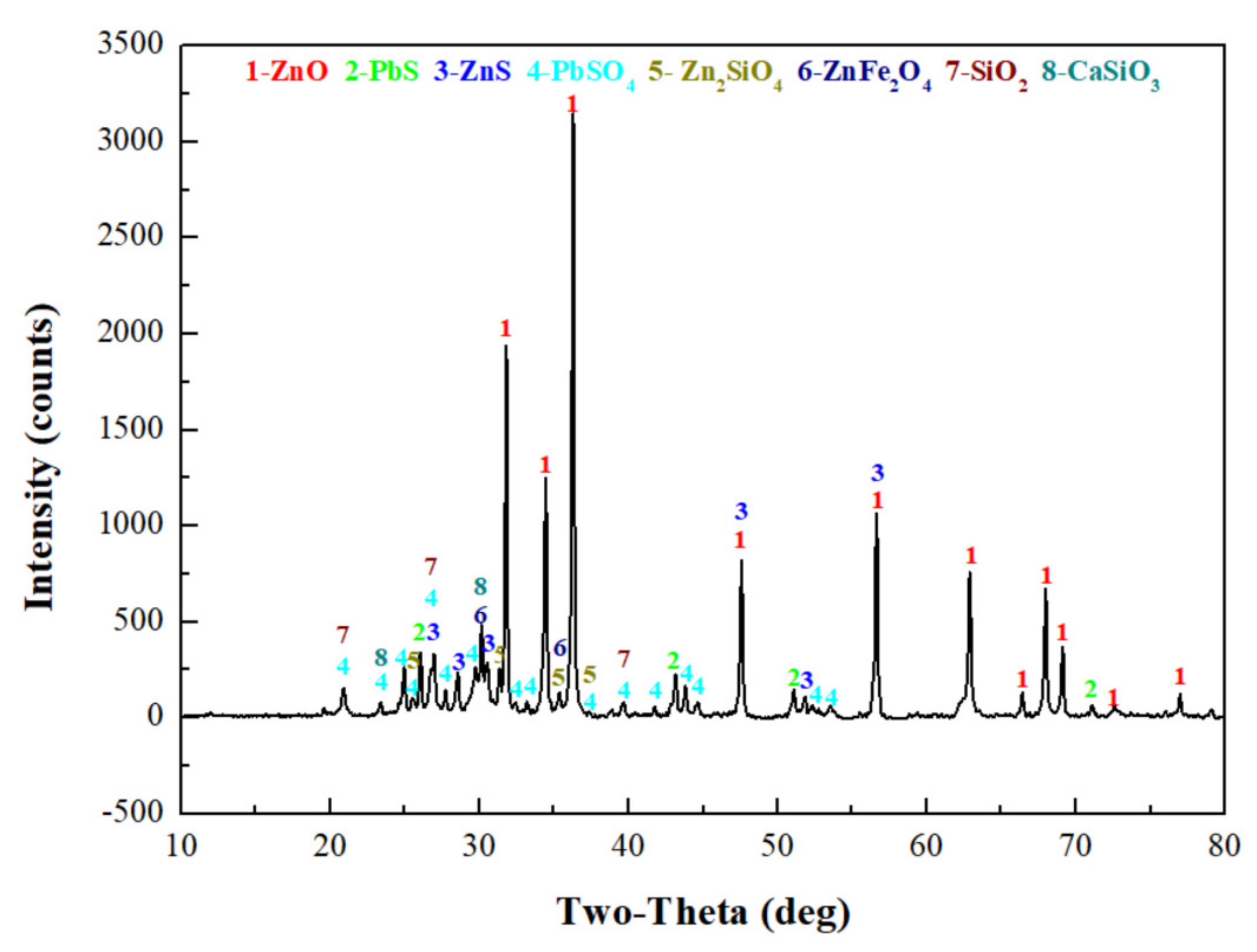
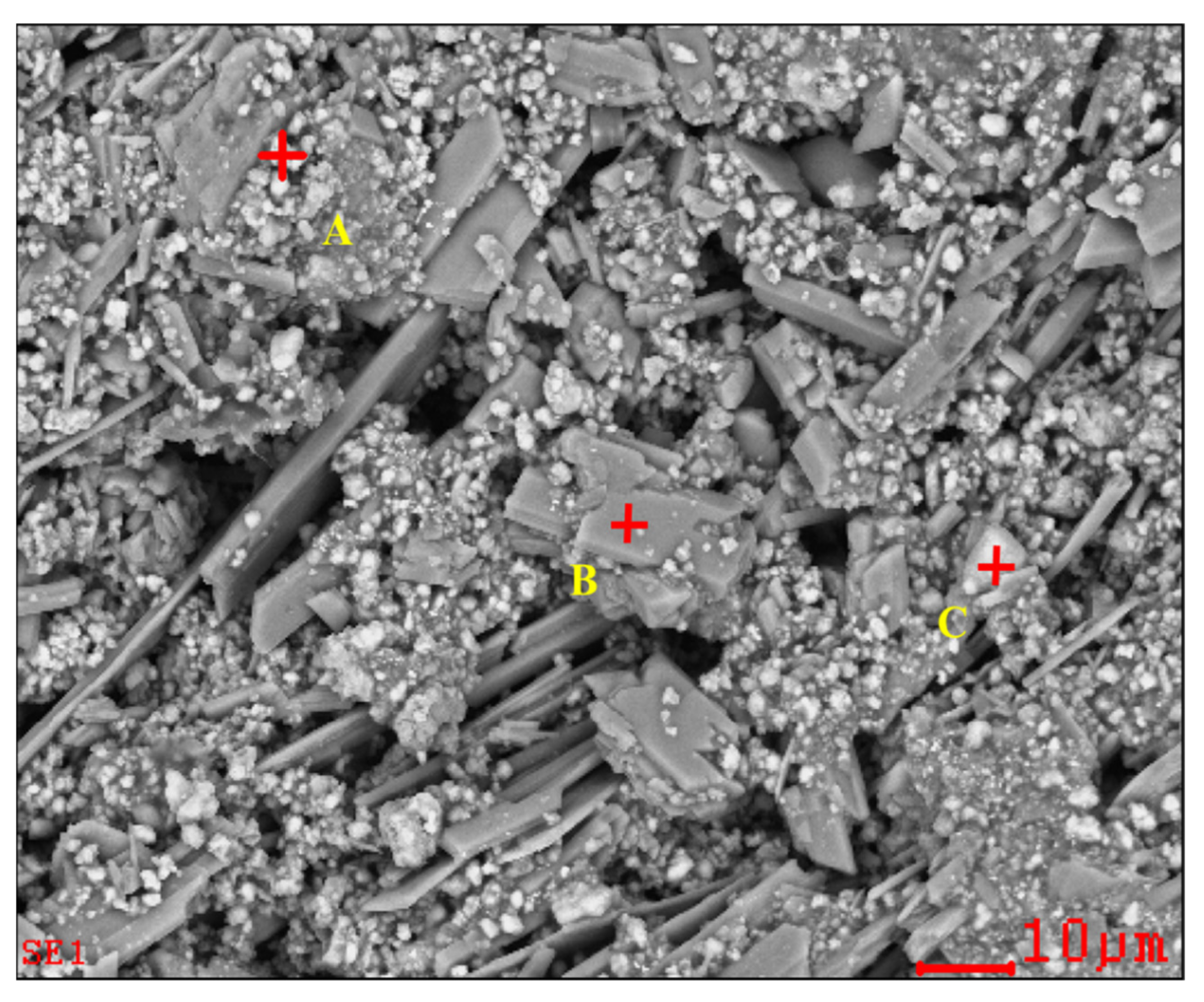
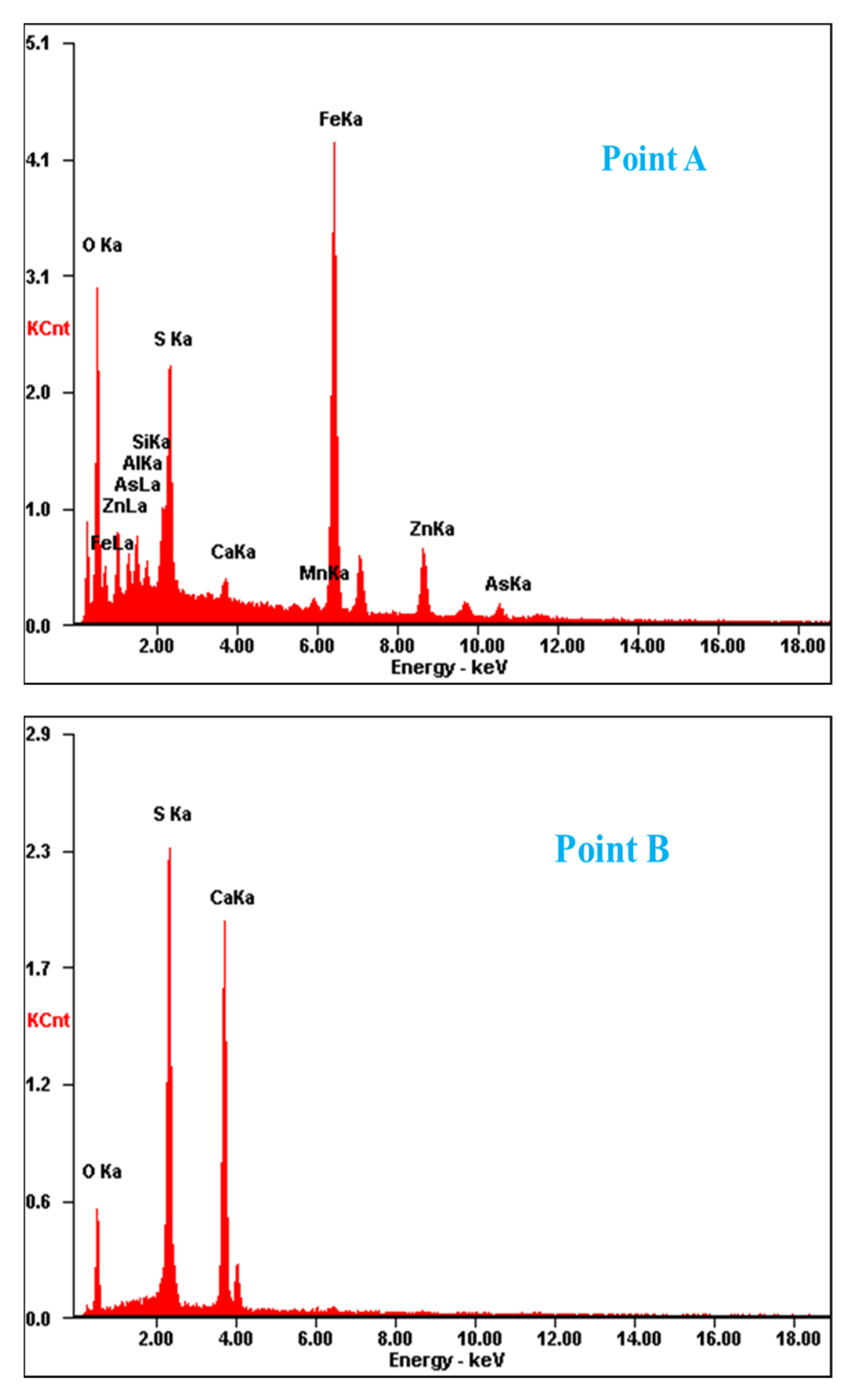
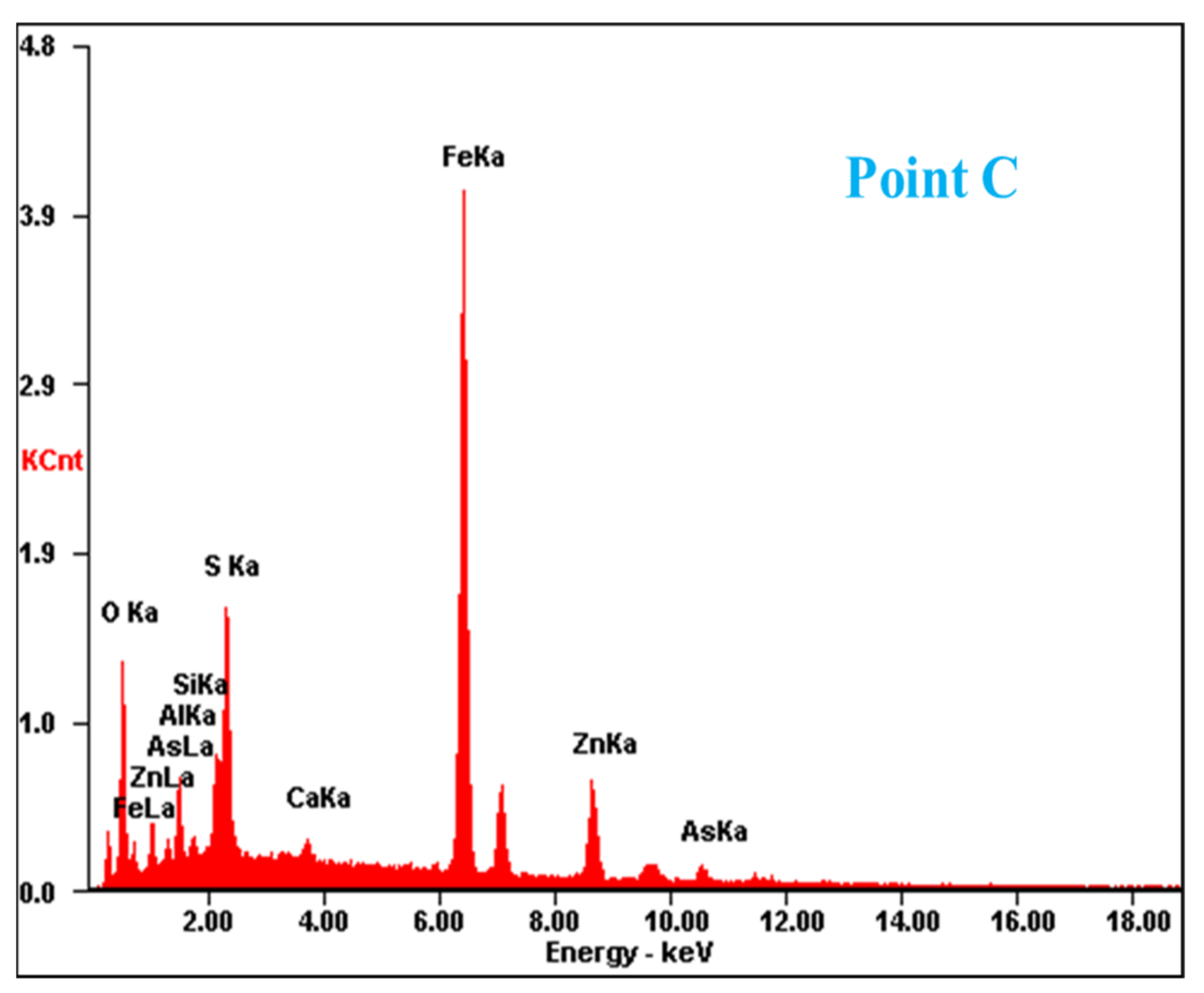
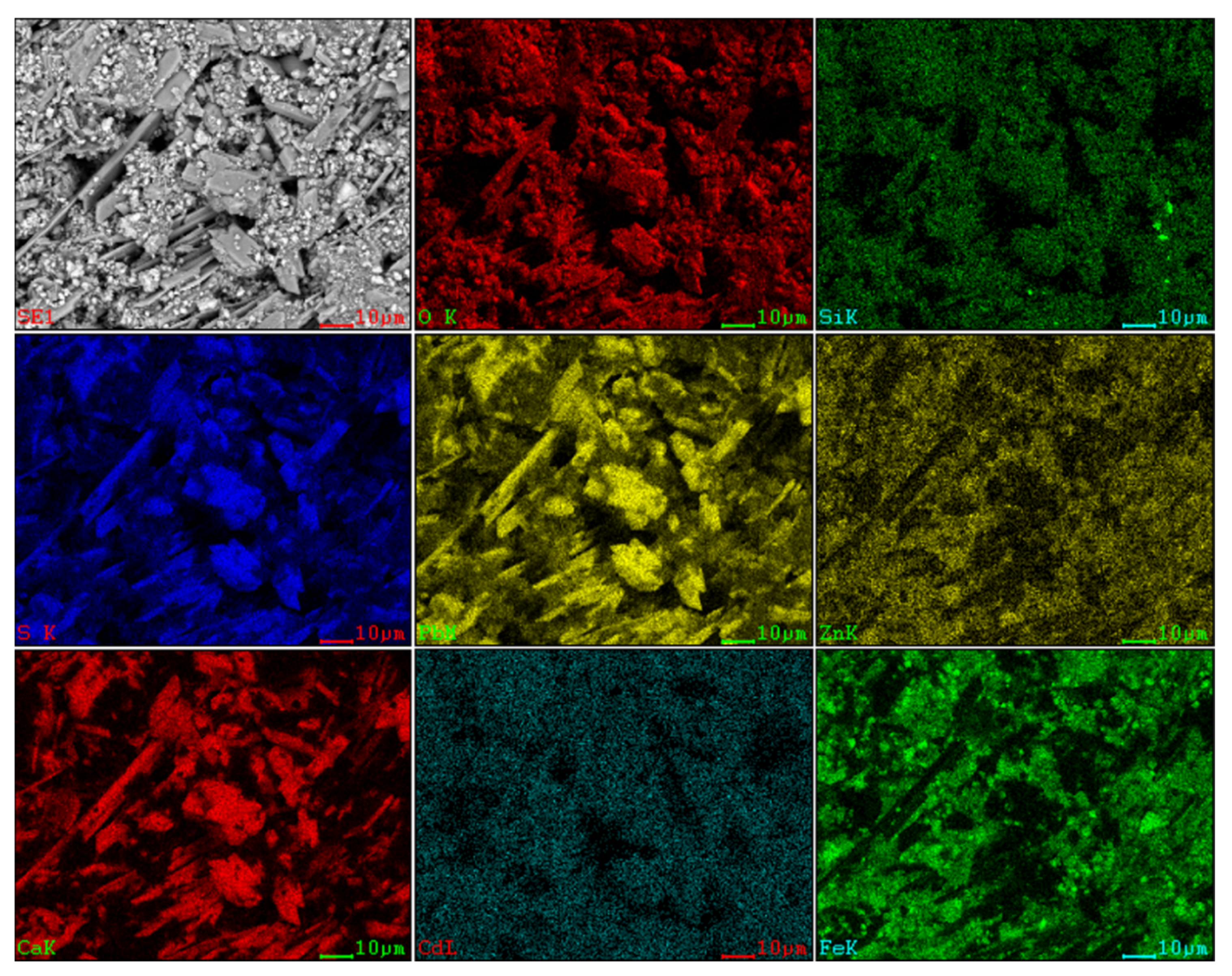


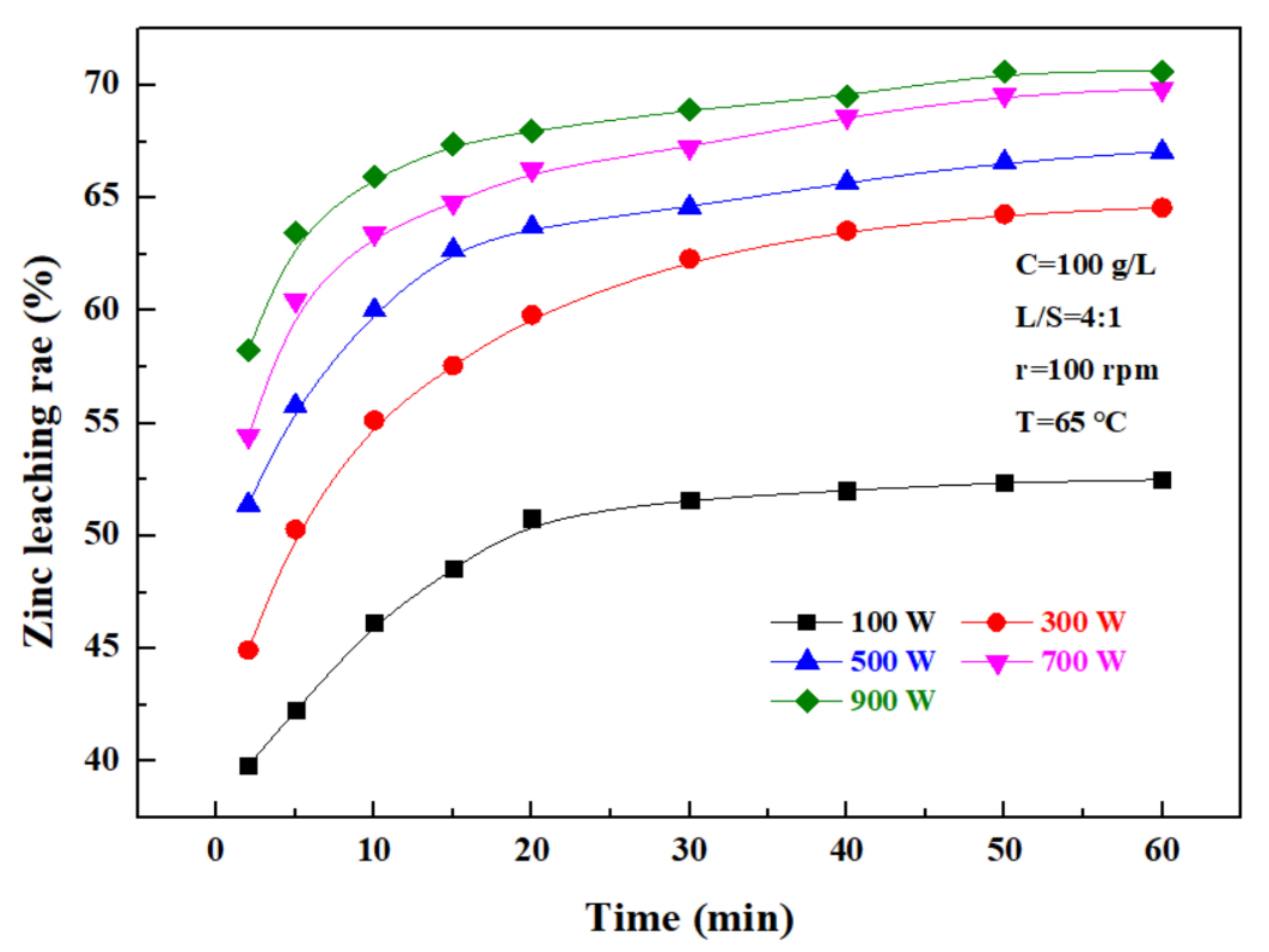
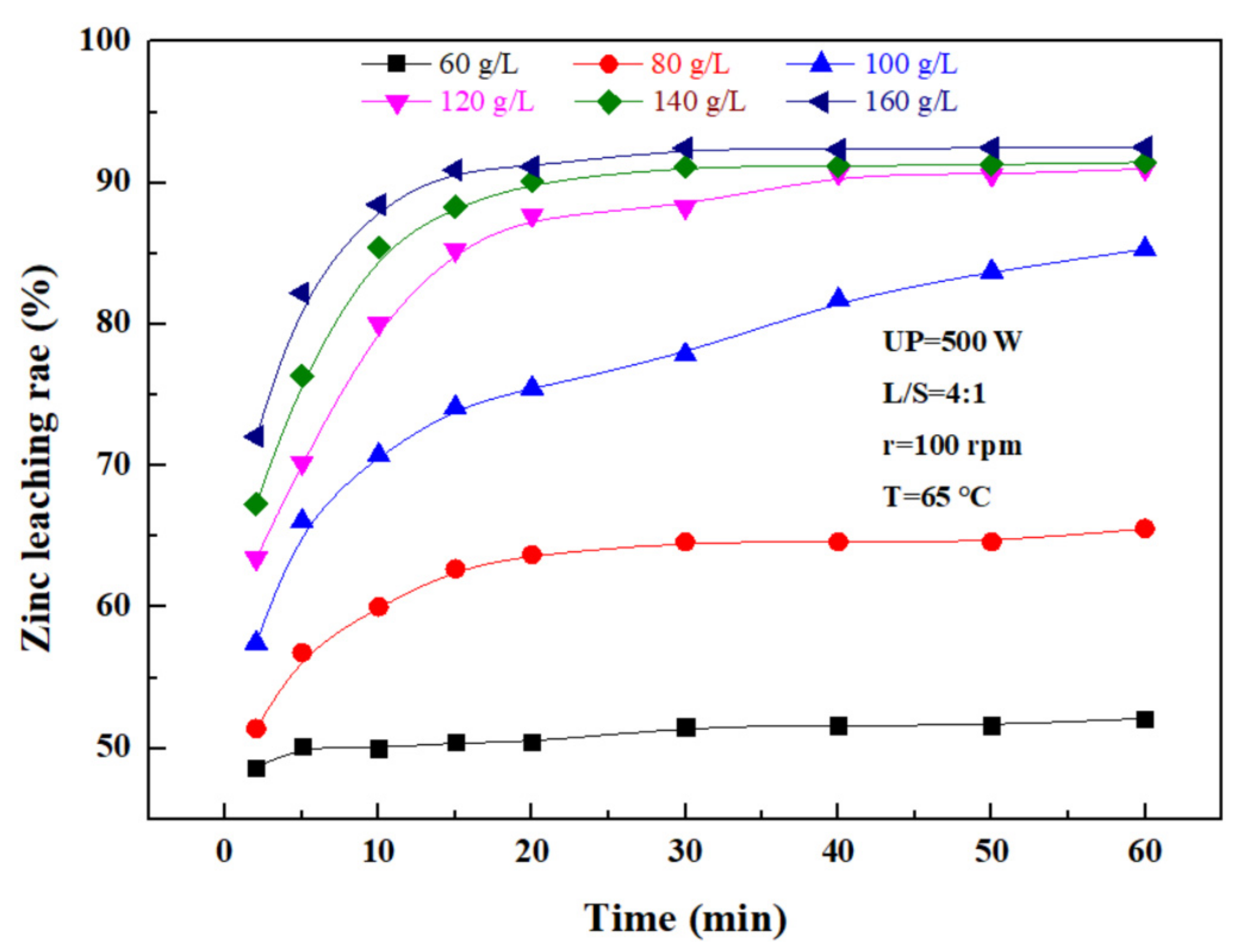




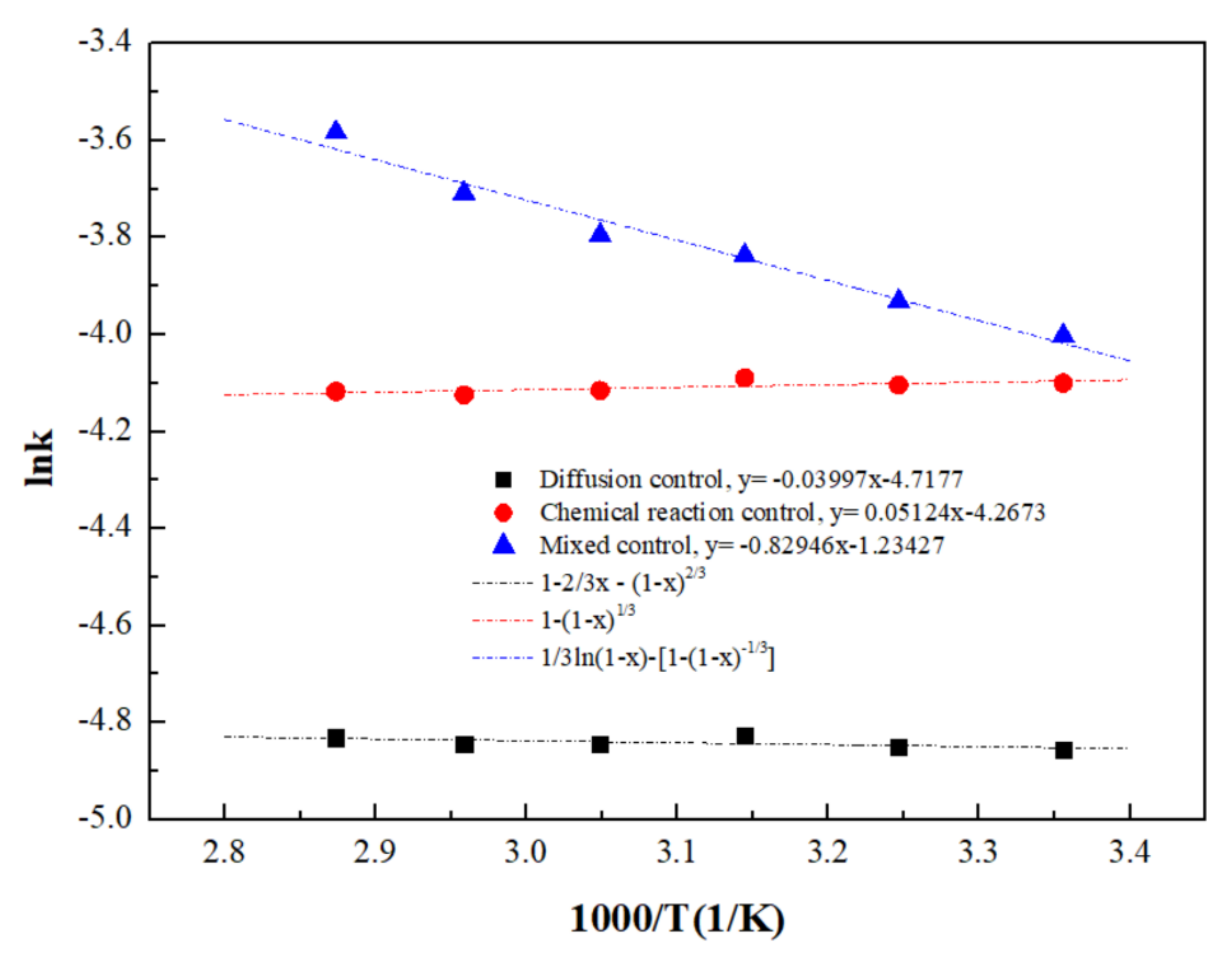
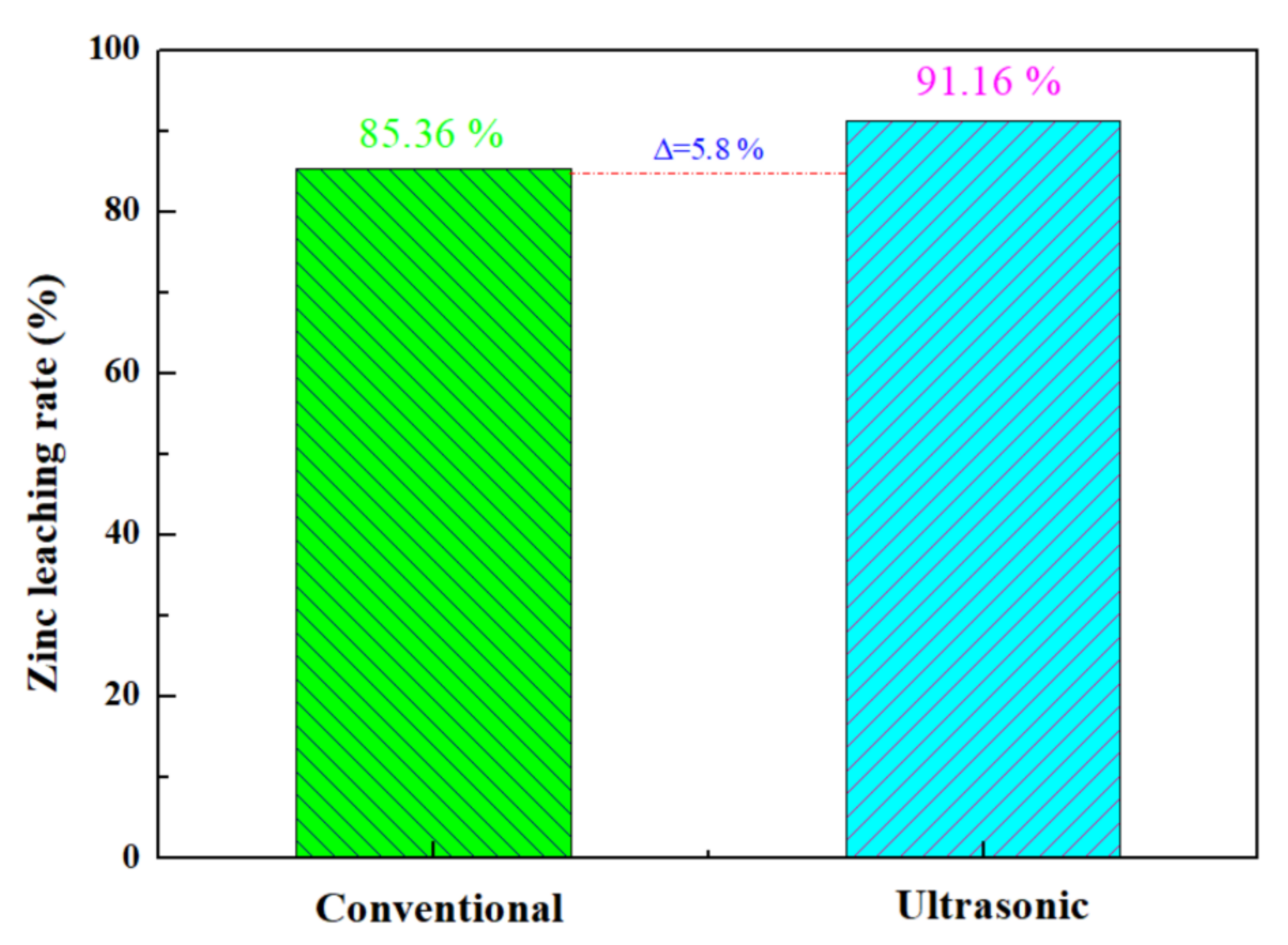

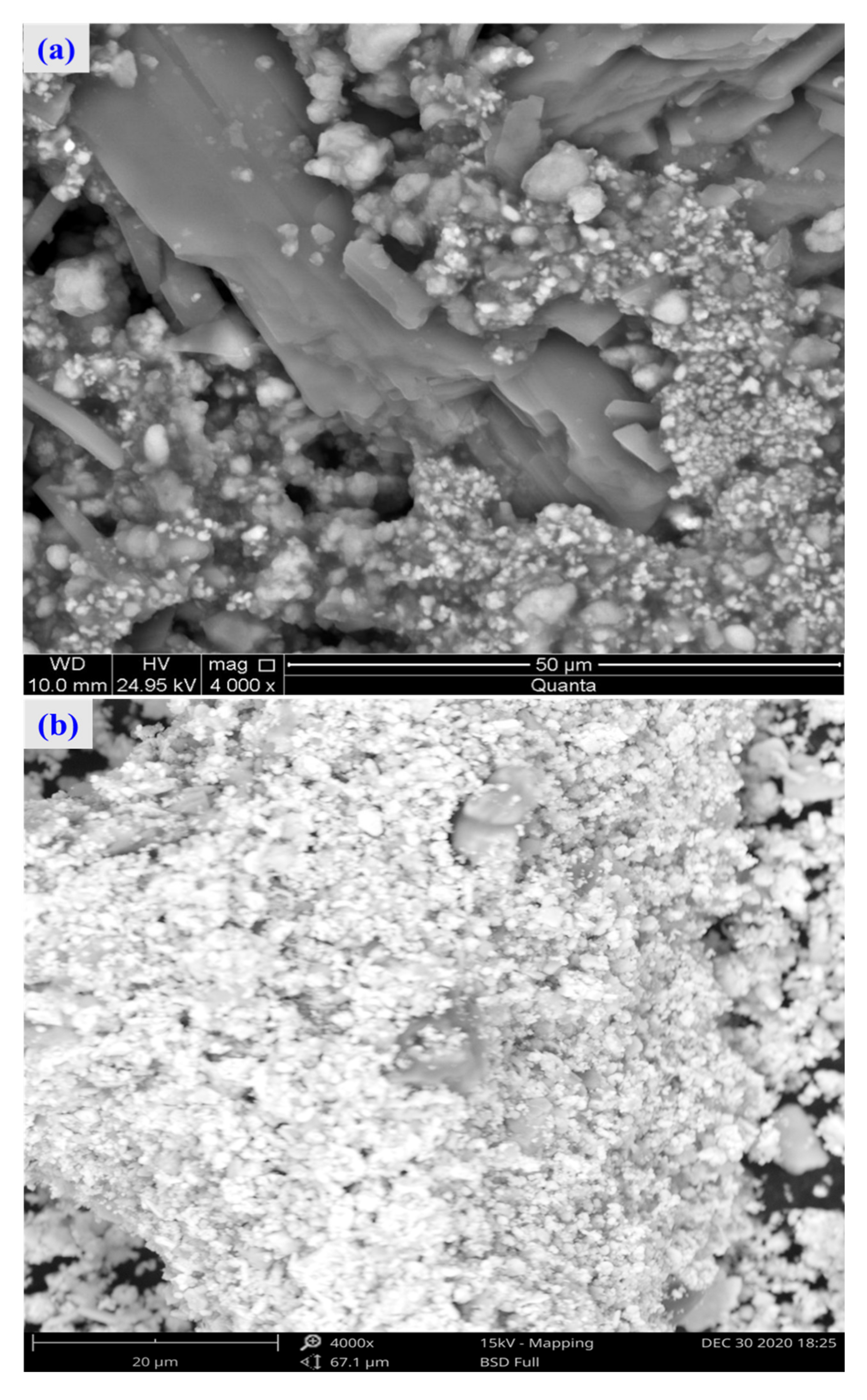
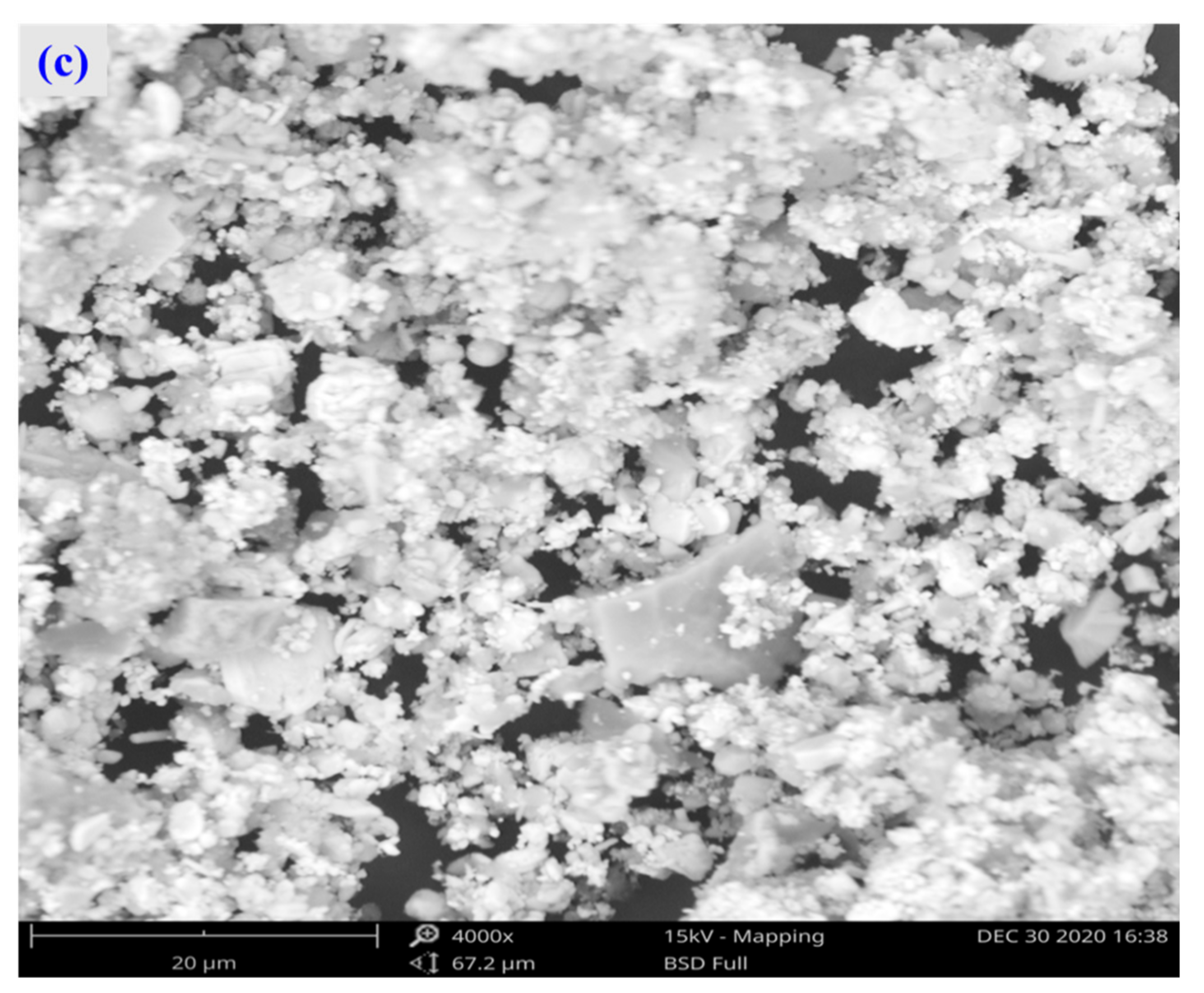
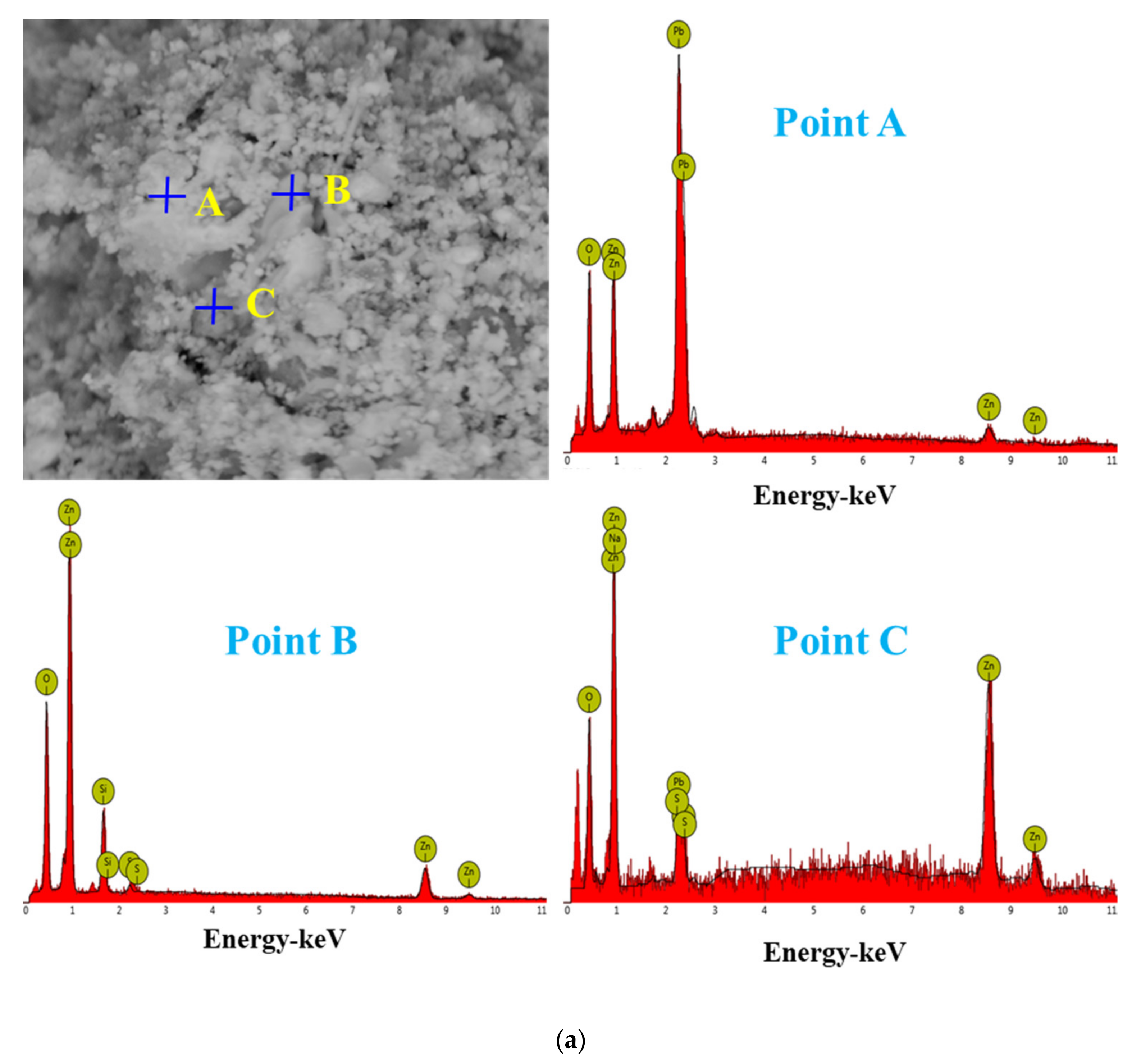


| Element | Zn | Pb | Cd | Fe | Mn | S |
|---|---|---|---|---|---|---|
| Content/% | 41.37 | 19.77 | 1.01 | 2.05 | 0.20 | 3.95 |
| Element | Cl | Si | Ca | In | F | |
| Content/% | 0.28 | 0.19 | 0.12 | 820.8 g/t | <0.01 |
| T (°C) | 1 − 2/3x − (1 − x) 2/3 | 1 − (1 − x)1/3 | 1/3ln(1 − x) – 1 + (1 − x)−1/3 | |||
|---|---|---|---|---|---|---|
| kd | R2 | kr | R2 | k0 | R2 | |
| 25 | 0.00778 | 0.9738 | 0.01658 | 0.9689 | 0.01827 | 0.9870 |
| 35 | 0.00782 | 0.9416 | 0.01651 | 0.9300 | 0.01961 | 0.9868 |
| 45 | 0.00802 | 0.9495 | 0.01675 | 0.9399 | 0.02156 | 0.9917 |
| 55 | 0.00788 | 0.9603 | 0.01632 | 0.9542 | 0.02249 | 0.9926 |
| 65 | 0.00788 | 0.9452 | 0.01618 | 0.9387 | 0.02452 | 0.9924 |
| 75 | 0.00798 | 0.9436 | 0.01629 | 0.9374 | 0.02780 | 0.9989 |
| Samples | D10 (μm) | D50 (μm) | D90 (μm) | Dav (μm) | Surface Area-to-Volume Ratio (m2/cm3) |
|---|---|---|---|---|---|
| A | 0.821 | 1.047 | 1.230 | 1.031 | 5.9886 |
| B | 1.038 | 1.355 | 1.608 | 1.336 | 4.6482 |
| C | 0.725 | 0.871 | 1.007 | 0.861 | 7.0916 |
Publisher’s Note: MDPI stays neutral with regard to jurisdictional claims in published maps and institutional affiliations. |
© 2022 by the authors. Licensee MDPI, Basel, Switzerland. This article is an open access article distributed under the terms and conditions of the Creative Commons Attribution (CC BY) license (https://creativecommons.org/licenses/by/4.0/).
Share and Cite
Zheng, X.; Li, S.; Liu, B.; Zhang, L.; Ma, A. A Study on the Mechanism and Kinetics of Ultrasound-Enhanced Sulfuric Acid Leaching for Zinc Extraction from Zinc Oxide Dust. Materials 2022, 15, 5969. https://doi.org/10.3390/ma15175969
Zheng X, Li S, Liu B, Zhang L, Ma A. A Study on the Mechanism and Kinetics of Ultrasound-Enhanced Sulfuric Acid Leaching for Zinc Extraction from Zinc Oxide Dust. Materials. 2022; 15(17):5969. https://doi.org/10.3390/ma15175969
Chicago/Turabian StyleZheng, Xuemei, Shiwei Li, Bingguo Liu, Libo Zhang, and Aiyuan Ma. 2022. "A Study on the Mechanism and Kinetics of Ultrasound-Enhanced Sulfuric Acid Leaching for Zinc Extraction from Zinc Oxide Dust" Materials 15, no. 17: 5969. https://doi.org/10.3390/ma15175969





